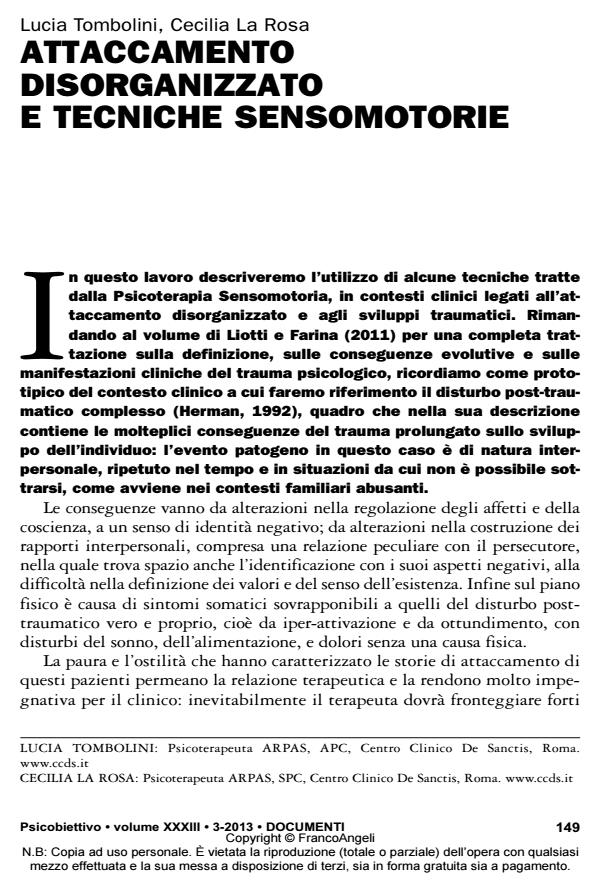Disorganized attachment and sensorymotor techniques
Journal title PSICOBIETTIVO
Author/s Lucia Tombolini, Cecilia La Rosa
Publishing Year 2014 Issue 2013/3 Language Italian
Pages 15 P. 149-163 File size 135 KB
DOI 10.3280/PSOB2013-003010
DOI is like a bar code for intellectual property: to have more infomation
click here
Below, you can see the article first page
If you want to buy this article in PDF format, you can do it, following the instructions to buy download credits

FrancoAngeli is member of Publishers International Linking Association, Inc (PILA), a not-for-profit association which run the CrossRef service enabling links to and from online scholarly content.
Treating trauma and related symptoms need to be focused on the therapeutic relationship and on how to cope with the trauma memories. About the therapeutic relationship the emotions and their regulation will have a very important role. To cope with trauma memories therapist has to be expert and use it in a late step of the therapy after a good relationship has set up and looking to patient metacognition ability. The authors explain the Sensorimotor Psychotherapy procedure and try to describe a possible integration in Cognitive Evolutionistic Psychotherapy.
Keywords: Thrauma; Disorganized Attachment; Sensorimotor Psychotherapy; Defense System; Therapeutic Relationship.
- Attili G. (2007) Attaccamento e costruzione evoluzionistica della mente. Normalità, patologia, terapia, Raffaello Cortina, Milano
- Courtois C.A., Ford J.D. (2009) Treating Complex Traumatic Stress Disorders, Guilford Press, New York-London
- Courtois C.A, Ford J.D., Cloitre M. (2009) “Best practices in psychotherapy for adults”, in Courtois C.A., Ford J.D. (eds.), Treating Complex Traumatic Stress Disorders, Guilford Press, New York-London
- Fisher J., Ogden P. (2009) “Sensorimotor Psychotherapy”, in Courtois C.A., Ford J.D. (eds.), Treating Complex Traumatic Stress Disorders, Guilford Press, New York-London Fonagy P., Gergely G., Jurist E. J., Target M. (2002) Affect Regulation, Mentalization, and the Development of the Self, Other Press, New York (trad. it. Regolazione affettiva, mentalizzazione e sviluppo del sé, Raffaello Cortina, Milano, 2005)
- Fraiberg S. (1982) “Pathological defenses in infancy”, Psychoanalitic Quarterly, 51: 612-635 (trad. it. in Il sostegno allo sviluppo, Raffaello Cortina, Milano, 1995)
- Porges S.W. (2001) “The Polyvagal theory: Phylogenetic substrates of a social nervous system”, Annals of New York Academy of Sciences, 807: 62-77
- Henninghausen K.H., Lyons-Ruth K. (2005) “Disorganization of behavioural and attentional strategies toward primary attachment figures: From biologic to dialogic processes”, in Carter C.S., Anhert L., Grossmann K.E., Hrdy S.B., Lamb M.E., Porges S.W., Sachser N. (eds.), Attachment and bonding: A new synthesis. In Dahlem Workshop Report, MIT Press, Cambridge, Ma, pp. 377-391
- Herman J.L. (1992) Trauma and Recovery, Basic Books, New York (trad. it. Guarire dal trauma: affrontare le conseguenze della violenza, dall’abuso domestico al terrorismo, Edizioni MaGi, Roma, 2005)
- Hesse H., Main M., Abrams K., Yrifkin A. (2003) “Unresolved states regarding loss or abuse can have second generation effects. Disorganized, role-inversion and frightening ideation in the offspring of traumatized non-maltreating parents”, in Solomon M.F., Siegel D.J. (eds.), Healing Trauma: Attachment, Mind, Body and Brain, Norton, New York
- Hesse H., Main M. (2006) “Frightened, threatening, and dissociative parental behavior in low-risk samples: Description, discussion, and interpretations”, Development and Pychopathology, 18: 309-343
- Janet P. (1925) Principles of psychotherapy, Allen & Unwin, London
- Kurtz R. (1990) Body-centered psychotherapy: The Hakomi method, Life Rhythm, Mendicino, CA
- Liotti G. (2001) Le opere della coscienza, Raffaello Cortina, Milano
- Liotti G. (2004) “Trauma, dissociation and disorganized attachment: Three strands of a single braid”, Psychotherapy: Theory, Research, Practice, Training, 41:
- 472-486
- Liotti G., Farina B. (2011) Sviluppi traumatici, Raffaello Cortina, Milano
- Liotti G., Mollon P., Miti G. (2005) “Dissociative disorders”, in Gabbard G., Beck J., Holmes E.A. (eds.), Oxford textbook of Psychotherapy, Oxford University Press, Oxford, pp. 205-213
- Liotti G., Monticelli F. (2008) I sistemi motivazionali nel dialogo clinico, Raffaello Cortina, Milano
- Lister E. (1982) “The forced silence: a neglected dimension of trauma”, American Journal of Psychiatry, 139: 872-876
- Lyons-Ruth K., Bronfman E., Parsons E. (1999) “Maternal frightened, frightening, or atypical behavior and disorganized infant attachment patterns”, in Vondra J.I., Barnett D. (eds.), A typical patterns of infant attachment: Theory, research, and current directions. Monograph of the society of research in Child Development, 64: 67-96
- Lyons-Ruth K., Yellin C., Melnick S., Atwood G. (2005) “Expanding the con- cept of unresolved mental states: Hostile/Helpless states of mind on the Adult Attachment Interview are associated with disrupted mother-infant communication and infant disorganization”, Development Psychopathology, 17: 1-23
- Lyons-Ruth K., Jacobvitz D. (2008) “Attachment disorganization: Genetic factors, parenting contexts, and developmental transformation from infancy to adulthood”, in Cassidy J., Shaver P. (eds.), Handbook of Attachment: Theory, Research and Clinical Applications, Guilford Press, New York (trad. it. Manuale dell’attaccamento, Giovanni Fioriti, Roma, 2010)
- Main M., Hesse E. (1990) “Parents’ unresolved traumatic experiences are related to infant disorganized attachment status: Is frightened and/or frightening parental behavior the linking mechanism?”, in Greenberg M.T., Cicchetti D., Cummings E.M. (eds.), Attachment in the preschool years: Theory, research and intervention, University of Chicago Press, Chicago
- Ogden P., Minton K. (2000) “Sensorimotor psychotherapy: One method for processing traumatic memory”, Traumatology, 6: 1-20
- Ogden P., Minton K., Pain C. (2006) Trauma and the Body, Norton, New York-London
- Solomon J., George C. (2011) “Disorganization of maternal caregiving across two generations: The origins of caregiving helplessness”, in Solomon J., George C. (eds.), Disorganization of attachment and Caregiving, Guilford Press, New York
- Van der Hart O, Dorahy M. (2009) “History of the concept of dissociation”, in Dell P., O’Neil J.A. (eds.), Dissociation and Dissociative Disorders: DSM-V and Beyond, Routledge, New York, pp. 3-26
- Van der Hart O., Nijenhuis E.R.S., Steele K. (2006) The Haunted Self (trad. it. Fantasmi nel sé. Trauma e trattamento della dissociazione strutturale, Raffaello Cortina, Milano, 2012)
Lucia Tombolini, Cecilia La Rosa, Attaccamento disorganizzato e tecniche sensomotorie in "PSICOBIETTIVO" 3/2013, pp 149-163, DOI: 10.3280/PSOB2013-003010